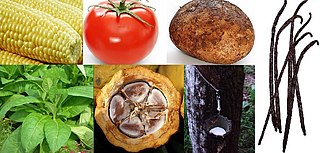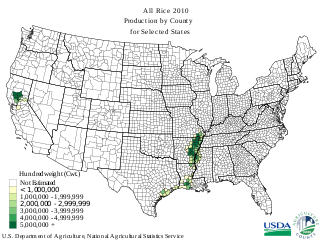Related Research Articles

Georgetown is the third oldest city in the U.S. state of South Carolina and the county seat of Georgetown County, in the Lowcountry. As of the 2010 census it had a population of 9,163. Located on Winyah Bay at the confluence of the Black, Great Pee Dee, Waccamaw, and Sampit rivers, Georgetown is the second largest seaport in South Carolina, handling over 960,000 tons of materials a year, while Charleston is the largest.

The Columbian exchange, also known as the Columbian interchange, was the widespread transfer of plants, animals, precious metals, commodities, culture, human populations, technology, diseases, and ideas between the New World in the Western Hemisphere, and the Old World (Afro-Eurasia) in the Eastern Hemisphere, in the late 15th and following centuries. It is named after the Italian explorer Christopher Columbus and is related to the European colonization and global trade following his 1492 voyage. Some of the exchanges were purposeful; some were accidental or unintended. Communicable diseases of Old World origin resulted in an 80 to 95 percent reduction in the number of Indigenous peoples of the Americas from the 15th century onwards, most severely in the Caribbean. The cultures of both hemispheres were significantly impacted by the migration of people from the Old World to the New. European colonists and African slaves replaced Indigenous populations across the Americas, to varying degrees. The number of Africans taken to the New World was far greater than the number of Europeans moving to the New World in the first three centuries after Columbus.

The Gullah are an African American ethnic group who predominantly live in the Lowcountry region of the U.S. states of South Carolina, North Carolina, Georgia, and Florida within the coastal plain and the Sea Islands. Their language and culture have preserved a significant influence of Africanisms as a result of their historical geographic isolation and the community's relation to their shared history and identity.

Sugar plantations in the Caribbean were a major part of the economy of the islands in the 18th, 19th, and 20th centuries. Most Caribbean islands were covered with sugar cane fields and mills for refining the crop. The main source of labor, until the abolition of chattel slavery, was enslaved Africans. After the abolition of slavery, indentured laborers from India, China, Portugal and other places were brought to the Caribbean to work in the sugar industry. These plantations produced 80 to 90 percent of the sugar consumed in Western Europe, later supplanted by European-grown sugar beet.
A plantation economy is an economy based on agricultural mass production, usually of a few commodity crops, grown on large farms worked by laborers or slaves. The properties are called plantations. Plantation economies rely on the export of cash crops as a source of income. Prominent crops included cotton, rubber, sugar cane, tobacco, figs, rice, kapok, sisal, and species in the genus Indigofera, used to produce indigo dye.

Slavery in the Spanish American colonies was an economic and social institution which existed throughout the Spanish Empire including Spain itself. In its American territories, early Spanish monarchs put forth laws against enslaving Indigenous peoples of the Americas. Queen Isabella outlawed the enslavement of Native Americans in the Spanish colonies of the New World because she viewed the natives as subjects of the Spanish monarchy. While Spain displayed an early abolitionist stance towards the Indigenous, some instances of illegal Native American slavery continued to be practiced by rogue individuals, particularly until the New Laws of 1543 which expressly prohibited it.
Antebellum South Carolina is typically defined by historians as South Carolina during the period between the War of 1812, which ended in 1815, and the American Civil War, which began in 1861.

The institution of slavery in North America existed from the earliest years of the colonial history of the United States until 1865 when the Thirteenth Amendment abolished slavery throughout the United States except as punishment for a crime. It was also abolished among the sovereign Indian tribes in Indian Territory by new peace treaties which the US required after the Civil War.
Peter Hutchins Wood is an American historian and author of Black Majority: Negroes in Colonial South Carolina from 1670 through the Stono Rebellion (1974). It has been described as one of the most influential books on the history of the American South of the past 50 years. He is a professor at Duke University in North Carolina.
Seasoning, or the Seasoning, was the period of adjustment that slave traders and slaveholders subjected African slaves to following their arrival in the Americas. While modern scholarship has occasionally applied this term to the brief period of acclimatization undergone by European immigrants to the Americas, it most frequently and formally referred to the process undergone by enslaved people. Slave traders used "seasoning" in this colonial context to refer to the process of adjusting the enslaved Africans to the new climate, diet, geography, and ecology of the Americas. The term applied to both the physical acclimatization of the enslaved person to the environment and that person's adjustment to a new social environment, labor regimen, and language. Slave traders and owners believed that if slaves survived this critical period of environmental seasoning, they were less likely to die and the psychological element would make them more easily controlled. This process took place immediately after the arrival of enslaved people during which their mortality rates were particularly high. These "new" or "saltwater" slaves were called "outlandish" on arrival. Those who survived this process became "seasoned", and typically commanded a higher price in the market. For example, in eighteenth century Brazil, the price differential between "new" and "seasoned" slaves was about fifteen percent.

Oryza glaberrima, commonly known as African rice, is one of the two domesticated rice species. It was first domesticated and grown in West Africa around 3,000 years ago. In agriculture, it has largely been replaced by higher-yielding Asian rice, and the number of varieties grown is declining. It still persists, making up an estimated 20% of rice grown in West Africa. It is now rarely sold in West African markets, having been replaced by Asian strains.

The economy of South Carolina was ranked the 25th largest in the United States based on gross domestic product in 2022. Tourism, centered around Myrtle Beach, Charleston, and Hilton Head Island, is the state's largest industry. The state's other major economic sector is advanced manufacturing located primarily in the Upstate and the Lowcountry.

Slave breeding was the practice in slave states of the United States of slave owners to systematically force the reproduction of slaves to increase their profits. It included coerced sexual relations between male slaves and women or girls, forced pregnancies of female slaves, and favoring women or young girls who could produce a relatively large number of children. The objective was to increase the number of slaves without incurring the cost of purchase, and to fill labor shortages caused by the abolition of the Atlantic slave trade.
Joshua John Ward, of Georgetown County, South Carolina, is known as the largest American slaveholder, dubbed "the king of the rice planters".

Tobacco cultivation and exports formed an essential component of the American colonial economy. It was distinct from rice, wheat, cotton and other cash crops in terms of agricultural demands, trade, slave labor, and plantation culture. Many influential American revolutionaries, including Thomas Jefferson and George Washington, owned tobacco plantations, and were hurt by debt to British tobacco merchants shortly before the American Revolution. For the later period see History of commercial tobacco in the United States.

Plantation complexes were common on agricultural plantations in the Southern United States from the 17th into the 20th century. The complex included everything from the main residence down to the pens for livestock. Until the abolition of slavery, such plantations were generally self-sufficient settlements that relied on the forced labor of enslaved people.

Black Barbadians/Bajans, African Barbadians/Bajans, or Afro-Barbadians/Bajans are Barbadians of entirely or predominantly African descent.

The role of African Americans in the agricultural history of the United States includes roles as the main work force when they were enslaved on cotton and tobacco plantations in the Antebellum South. After the Emancipation Proclamation in 1863-1865 most stayed in farming as very poor sharecroppers, who rarely owned land. They began the Great Migration to cities in the mid-20th century. About 40,000 are farmers today.

Rice production is the fourth largest among cereals in the United States, after corn, wheat, and sorghum. Of the country's row crop farms, rice farms are the most capital-intensive, and have the highest national land rental rate average. In the US, all rice acreage requires irrigation. In 2000-09 approximately 3.1 million acres in the US were under rice production; an increase was expected over the next decade to approximately 3.3 million acres. USA Rice represents rice producers in the six largest rice-producing states of Arkansas, California, Louisiana, Mississippi, Missouri, and Texas.

Carolina Gold rice is a variety of African rice first popularized in South Carolina, USA in the 1780s. It is named for the golden color of its unhulled grains.
References
- ↑ Judith Carney, Black Rice, (Cambridge: Harvard University Press, 2001): 98-101
- ↑ Philip D. Morgan, "Work and Culture: The Task System and the World of Lowcountry Blacks, 1700 to 1880," William and Mary Quarterly 39, no. 4 (October 1982), 568;Black Rice : 99
- ↑ Judith Carney, Black Rice, (Cambridge: Harvard University Press, 2001): 108
- ↑ Judith Carney, Black Rice, (Cambridge: Harvard University Press, 2001) : 78-106
- ↑ Black Rice : 89
- ↑ Judith Carney, "Black Rice", (Cambridge: Harvard University Press, 2001): 68